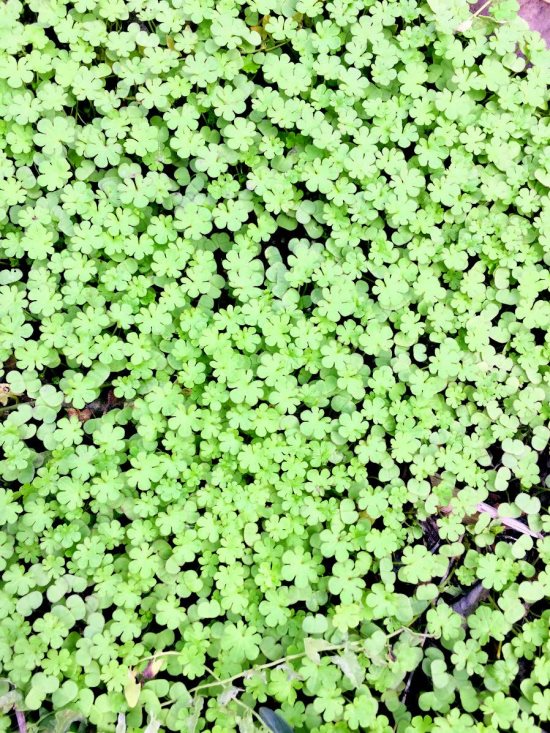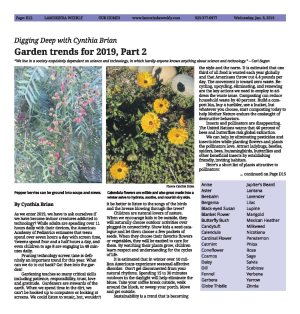|
|
Published January, 9th 2019
|
Digging Deep with Cynthia Brian
|
| Garden trends for 2019, Part 2 |
| By Cynthia Brian |
 |
| Pepper berries can be ground into soups and stews. Photos Cynthia Brian |
"We live in a society exquisitely dependent on science and technology, in which hardly anyone knows anything about science and technology." - Carl Sagan
 As we enter 2019, we have to ask ourselves if we have become indoor creatures addicted to technology? While adults are spending over 11 hours daily with their devices, the American Academy of Pediatrics estimates that teens spend over seven hours a day with screen time, `tweens spend four and a half hours a day, and even children to age 8 are engaging in 48 minutes daily.
As we enter 2019, we have to ask ourselves if we have become indoor creatures addicted to technology? While adults are spending over 11 hours daily with their devices, the American Academy of Pediatrics estimates that teens spend over seven hours a day with screen time, `tweens spend four and a half hours a day, and even children to age 8 are engaging in 48 minutes daily.
 Pruning technology screen time is definitely an important trend for this year. What can we do to cut back? Get thee into the garden!
Pruning technology screen time is definitely an important trend for this year. What can we do to cut back? Get thee into the garden!
 Gardening teaches so many critical skills including patience, responsibility, trust, love and gratitude. Gardeners are stewards of the earth. When we spend time in the dirt, we can't be hooked up to computers or looking at screens. We could listen to music, but, wouldn't it be better to listen to the songs of the birds and the breeze blowing through the trees?
Gardening teaches so many critical skills including patience, responsibility, trust, love and gratitude. Gardeners are stewards of the earth. When we spend time in the dirt, we can't be hooked up to computers or looking at screens. We could listen to music, but, wouldn't it be better to listen to the songs of the birds and the breeze blowing through the trees?
 Children are natural lovers of nature. When we encourage kids to be outside, they will naturally choose outdoor activities over plugged-in connectivity. Show kids a seed catalogue and let them choose a few packets of seeds. When they choose their favorite flowers or vegetables, they will be excited to care for them. By watching their plants grow, children learn respect and understanding for the cycles of life.
Children are natural lovers of nature. When we encourage kids to be outside, they will naturally choose outdoor activities over plugged-in connectivity. Show kids a seed catalogue and let them choose a few packets of seeds. When they choose their favorite flowers or vegetables, they will be excited to care for them. By watching their plants grow, children learn respect and understanding for the cycles of life.
 It is estimated that in winter over 10 million Americans experience seasonal affective disorder. Don't get disconnected from your natural rhythms. Spending 15 to 30 minutes outdoors in the daylight will help eliminate the blues. Take your coffee break outside, walk around the block, or sweep your porch. Move and get outside.
It is estimated that in winter over 10 million Americans experience seasonal affective disorder. Don't get disconnected from your natural rhythms. Spending 15 to 30 minutes outdoors in the daylight will help eliminate the blues. Take your coffee break outside, walk around the block, or sweep your porch. Move and get outside.
 Sustainability is a trend that is becoming the style and the norm. It is estimated that one third of all food is wasted each year globally and that Americans throw out 4.4 pounds per day. The movement is toward zero waste. Recycling, upcycling, eliminating, and renewing are the key actions we need to employ to address the waste issue. Composting can reduce household waste by 40 percent. Build a compost bin, buy a tumbler, use a bucket, but whatever you choose, start composting today to help Mother Nature endure the onslaught of destructive behaviors.
Sustainability is a trend that is becoming the style and the norm. It is estimated that one third of all food is wasted each year globally and that Americans throw out 4.4 pounds per day. The movement is toward zero waste. Recycling, upcycling, eliminating, and renewing are the key actions we need to employ to address the waste issue. Composting can reduce household waste by 40 percent. Build a compost bin, buy a tumbler, use a bucket, but whatever you choose, start composting today to help Mother Nature endure the onslaught of destructive behaviors.
 Insects and pollinators are disappearing. The United Nations warns that 40 percent of bees and butterflies risk global extinction. We can help by eliminating pesticides and insecticides while planting flowers and plants the pollinators love. Attract ladybugs, beetles, spiders, bees, hummingbirds, butterflies and other beneficial insects by establishing friendly, inviting habitats.
Insects and pollinators are disappearing. The United Nations warns that 40 percent of bees and butterflies risk global extinction. We can help by eliminating pesticides and insecticides while planting flowers and plants the pollinators love. Attract ladybugs, beetles, spiders, bees, hummingbirds, butterflies and other beneficial insects by establishing friendly, inviting habitats.
 Here's a short list of plants attractive to pollinators:
Here's a short list of plants attractive to pollinators:
 Anise
Anise
 Aster
Aster
 Beebalm
Beebalm
 Bergenia
Bergenia
 Black-eyed Susan
Black-eyed Susan
 Blanket Flower
Blanket Flower
 Butterfly Bush
Butterfly Bush
 Candytuft
Candytuft
 Calendula
Calendula
 Cardinal Flower
Cardinal Flower
 Catmint
Catmint
 Coneflower
Coneflower
 Cosmos
Cosmos
 Daisy
Daisy
 Dill
Dill
 Fennel
Fennel
 Gerbera
Gerbera
 Globe Thistle
Globe Thistle
 Jupiter's Beard
Jupiter's Beard
 Lantana
Lantana
 Lavender
Lavender
 Lilac
Lilac
 Lupine
Lupine
 Marigold
Marigold
 Mexican Heather
Mexican Heather
 Milkweed
Milkweed
 Nicotiana
Nicotiana
 Penstemon
Penstemon
 Phlox
Phlox
 Rose
Rose
 Sage
Sage
 Salvia
Salvia
 Scabiosa
Scabiosa
 Verbena
Verbena
 Yarrow
Yarrow
 Zinnia
Zinnia
 For optimum impact, plant in drifts or clusters. Pollinators seek fragrance and bright colors. By incorporating these flowers into your landscape you'll help save the beneficial bugs. Without them, the invasive, detrimental insects threaten our species.
For optimum impact, plant in drifts or clusters. Pollinators seek fragrance and bright colors. By incorporating these flowers into your landscape you'll help save the beneficial bugs. Without them, the invasive, detrimental insects threaten our species.
 Circling back to technology, artificial intelligence is taking root in the garden. Robotic mowers, drones that pollinate and "read the weeds," and wireless irrigation sensors are already in use. Walmart filed patents for drones to identify pests attacking crops. With these trends, it may not be long before we'll be able to instruct our smartphones to start the engines of a new tech device that will weed, seed and feed.
Circling back to technology, artificial intelligence is taking root in the garden. Robotic mowers, drones that pollinate and "read the weeds," and wireless irrigation sensors are already in use. Walmart filed patents for drones to identify pests attacking crops. With these trends, it may not be long before we'll be able to instruct our smartphones to start the engines of a new tech device that will weed, seed and feed.
 Until then, let's unplug, go outside, and dig deeper!
Until then, let's unplug, go outside, and dig deeper!
 Happy Gardening! Happy Growing!
Happy Gardening! Happy Growing! |
 |
| Calendula flowers are edible and also great made into a winter salve to hydrate, soothe, and nourish dry skin. |
 |
| Pull weeds as they sprout. |
 |
| Bergenia makes a long-lasting cut flower and pollinators are attracted to their pink petals. |
 |
| Prune fruit trees. |
 |
|
Persimmons |
 |
| Peace lilies
or sail plants purify the air. |
| |
 |
|
Cynthia Brian surrounded by snow-clad
branches Cynthia Brian, The Goddess Gardener, raised in the vineyards
of Napa County, is a New York Times best-selling author, actor, radio
personality, speaker, media and writing coach as well as the Founder
and Executive Director of Be the Star You Are1r 501 c3. Tune into
Cynthia's Radio show and order her books at
www.StarStyleRadio.com.
Buy a copy of her new books, Growing with the Goddess Gardener and Be
the Star You Are! Millennials to Boomers at
www.cynthiabrian.com/online-store. Hire Cynthia for projects,
consults, and lectures. Cynthia@GoddessGardener.com
www.GoddessGardener.com Donate to Fire Disaster Relief via Be the Star
You Are!r 501 c3 at www.BethestarYouAre.org |
| |
|
|
|












